THIS is a tale of bewilderment and defeat in a strange and hostile environment. It started out like any other day in the mountains ??? one man with a cheery whistle and a bag of food. Then things deteriorated . . .
The trail from Boca da Encumeada to Boca da Corrida ??? both of which are high passes in the mountains of Madeira ??? is a royal road. It was constructed centuries ago under the edict of a Portuguese monarch and, because of its status, was paved and maintained.
Noblemen could traverse its course above the dramatically beautiful valley of Curral das Freiras on fine horses, while noblewomen were carried in hammocks slung from the shoulders of lesser mortals. This is the day I could benefit from a hammock myself, because this is the day things go wrong big time.
Before I pull on my boots I???m going to furnish you with information I do not, myself, possess until much later in the day. This places you in a position of great advantage. Unknown to me, the main section of this royal road has been closed to walkers because of its dangerous condition. It transpires there is a warning sign at the Boca da Corrida end of the trail, but not the Boca da Encumeada end. Guess which end I???m sitting at, lacing up my boots. That???s right.
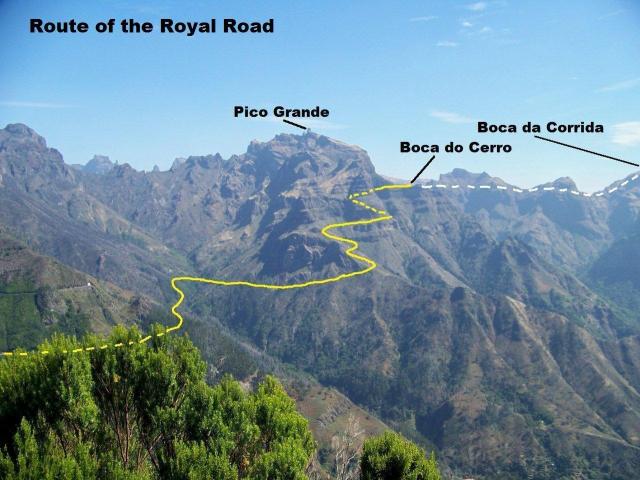 My plan is to traverse the royal road as far as Boca do Cerro, a col about two-thirds of the way along, and veer north to climb the awesome Pico Grande (1,654m or 5,426ft), which rises above the trail in great buttresses of grey rock. Then, suitably satisfied with this latest adventure, I shall return by my outward route. That???s the plan.
My plan is to traverse the royal road as far as Boca do Cerro, a col about two-thirds of the way along, and veer north to climb the awesome Pico Grande (1,654m or 5,426ft), which rises above the trail in great buttresses of grey rock. Then, suitably satisfied with this latest adventure, I shall return by my outward route. That???s the plan.
 So as the first morning rays slice through the eucalyptus forests I set out from Boca da Encumeada like a Portuguese nobleman who is not quite noble enough to own a horse. But I have, nevertheless, a jaunty spring in my step, despite a dodgy left knee which is supported by an elastic bandage I bought many years ago while cycling painfully through Barnard Castle. And after fifty minutes at a steady hobble, I chance upon a settlement ??? perched on terraces at the head of a steep and narrow valley ??? that has not altered in centuries.
So as the first morning rays slice through the eucalyptus forests I set out from Boca da Encumeada like a Portuguese nobleman who is not quite noble enough to own a horse. But I have, nevertheless, a jaunty spring in my step, despite a dodgy left knee which is supported by an elastic bandage I bought many years ago while cycling painfully through Barnard Castle. And after fifty minutes at a steady hobble, I chance upon a settlement ??? perched on terraces at the head of a steep and narrow valley ??? that has not altered in centuries.
The valley, Curral Jangao, is nipped between the soaring flanks of Pico Grande and Pico do Jorge on the island???s main spinal ridge. There are houses here but no road to them. The sole means of access is the mountain path along which I have walked.




 Some of the crude sheds and terraces have been abandoned, but a few are still occupied and worked. Amid the brambles and lush undergrowth of the sunny clearings, I spy cabbages and sweetcorn, and poles for growing judia beans (similar to runner beans but smoother-skinned and less stringy). In front of one of the shacks on the higher terraces sits a man in a stripy T-shirt. I give him a wave and he waves back. And I think: Jesus, what a perfect place to live, and in such perfect peace and solitude. Do these people spend their lives here, or do they use these remote terraces as a weekend retreat ??? an allotment in the hills?
Some of the crude sheds and terraces have been abandoned, but a few are still occupied and worked. Amid the brambles and lush undergrowth of the sunny clearings, I spy cabbages and sweetcorn, and poles for growing judia beans (similar to runner beans but smoother-skinned and less stringy). In front of one of the shacks on the higher terraces sits a man in a stripy T-shirt. I give him a wave and he waves back. And I think: Jesus, what a perfect place to live, and in such perfect peace and solitude. Do these people spend their lives here, or do they use these remote terraces as a weekend retreat ??? an allotment in the hills?
Just digressing momentarily ??? my wife and I have seen vast allotment sites on the outskirts of towns and cities in Poland and the Czech Republic where most plots are equipped with what the locals call summer houses. I walked through one of these sites in Sopot, near Gdansk, one Sunday morning. The scent of frying bacon wafted through the air; kettles whistled; some of the sheds had TV aerials. It was Polish heaven. Driving past another allotment site in the centre of Poland, near Chojnice, we spotted the fuselage of an aeroplane that had been converted into a summer house and was painted in bright colours, sitting amid neat beds of vegetables. What I wouldn???t have given to be its owner. And now, as I drift through groves of sweet chestnut and these silent though productive terraces in mountainous Madeira, I think of my own allotment plot in rain-soaked England with its 12ft x 8ft polytunnel and my heart sinks somewhat.
Beyond the settlement in Curral Jangao my royal road begins to peter out and is consumed by brambles and bracken as it climbs above the forest. Every now and then I chance upon a paved section ??? but it is not the paving of 17th Century craftsmen; it resembles the crazy paving of a 1960s patio laid by a Portuguese version of Alan Titchmarsh. My curiosity is aroused when I observe that several sections have slid hundreds of feet down the mountain, leaving royal gaps in the royal road which have to be crossed with care.

The royal road, now an indistinct and deteriorating path, snakes up the feet of Pico Grande and follows the gently-rising beds of rock

Another glance back down the royal road, just to make sure it???s still there and hasn???t slipped down the mountain
The path hugs the walls of two impressive corries, while following the gently-rising beds of volcanic rock. In places the brambles are so dense and have encroached upon the track so much it is not possible to place both feet side by side. There are situations where I have banks of brambles to my left, six or seven inches of paving on which to place a boot, and a plunge down a bottomless slope to my right. I am not at all happy and become increasingly agitated.
By the time I have rounded the second corrie I???m decidedly twitchy. This is slow, hard and sweaty going ??? and I???ve got a bloody big mountain to climb at the end of it. Then I round a corner into a third and hugely impressive corrie ??? the mighty Fenda do Ferreiro ??? and something stops me in my tracks.
Angry voices shout at me ??? Portuguese voices from the sheer face that forms Fenda do Ferreiro???s western wall. I hear the dull thud-thud of large stones bouncing down steep slopes and the sharp crack as they glance off rock. But I can see neither the people nor the boulders. The activity is taking place in the shadows of the cliff face and the forest at its foot. I stand still and the shouting stops. I move forward and it resumes. I???m at a loss ??? do I go forwards or backwards? I sit down on the path and get my bait out.
After chorizo, cheese and fresh bread I continue along the royal road, this time in silence. In Fenda do Ferreiro the path is obstructed by fallen trees and rock debris, making progress even slower. Not only have my arms and legs been scratched to hell by brambles, my T-shirt is covered with bobbles where it has been caught by the thorns and resembles a pair of those 1970s nylon Y-fronts that have been through the wash too many times. I???m feeling more than a little bit sorry for myself and on the brink of turning back.
But what???s this? Rounding the next corner I stumble ??? literally ??? upon a section of royal road that has been cleared of brambles, rocks and fallen trees. The original paving, laid by craftsmen in times long forgotten, pokes through the turf and demands to be trodden. This is a surprise indeed. No fierce brambles to prick the flesh and catch the garments; just a perfect pathway winding beneath the daunting walls of the corrie.
Stepping out with renewed gusto, I blunder into a group of Portuguese workmen ??? the sort of blokes you see laying kerbstones and stopping traffic ??? but these chaps are toiling at an altitude of several thousand feet and must be three or four miles from the nearest road end. They are rebuilding the royal road with mattocks, picks, shovels, and almost anything that has a handle. They are really going for it. Their tools glance off rocks and slice through earth. Stones are being rolled over the side of the track to bounce into oblivion. These blokes mean business.
They stand aside reluctantly as I pass. I say ???ol????? with an air of embarrassment and pick my way between them. They don???t say a single word. They just regard me with indifference. A couple actually glare at me. And I just know they are thinking: ???You stupid Englishman. Didn???t you hear us shouting? Can???t you see there is dangerous work going on here? Why don???t you just bugger off to the coast and get blotto on cheep beer like the rest of your countrymen????
Round the next corner I stand aside as a teenager struggles past with a bag of cement on his shoulders. I nod in a friendly manner but his gaze remains fixed on the path. Further on I encounter a second gang of workmen laying steps up a gradient. They have a small generator and cement mixer. How they got them up here is beyond me, and I do not feel disposed to ask.
The same uncomfortable scenario is enacted. They stand aside silently; I mutter ???ol?????; they stare with indifference; and I pick my way through. But this time it???s worse. I clump my right boot on a newly-laid step and the stone rolls out of its place. ???Ooh, sorry,??? I mutter. The chap whose work has been unravelled smiles at me sadly, as if he wants to say: ???That???s quite all right, senhor. If your boot had not destroyed my step, then the next man???s would. Thank you for bringing to my attention, and to the attention of my colleagues, the inferior quality of my workmanship.???


 Further up this royal road, which has become a royal motorway thanks to the efforts of the workmen, I observe the most pitiful of sights. I see a teenager wearing a hoodie, but both he and his garments are the colours of the mud and stones. His hood is pulled over his head and he is loading heavy slabs onto his own back. I stand and watch him. He stoops, almost bent double, lifts a slab over his head and places it ??? with great effort ??? on his shoulders. He then lifts a second slab and positions it on the back of his neck. Holding both slabs in place, he treads slowly down the path, his young body bent beneath the weight and the necessity to ensure his burden remains in position.
Further up this royal road, which has become a royal motorway thanks to the efforts of the workmen, I observe the most pitiful of sights. I see a teenager wearing a hoodie, but both he and his garments are the colours of the mud and stones. His hood is pulled over his head and he is loading heavy slabs onto his own back. I stand and watch him. He stoops, almost bent double, lifts a slab over his head and places it ??? with great effort ??? on his shoulders. He then lifts a second slab and positions it on the back of his neck. Holding both slabs in place, he treads slowly down the path, his young body bent beneath the weight and the necessity to ensure his burden remains in position.
I feel I have been transported back to mediaeval times. I am observing a scene that would have been commonplace when the great cathedrals of Europe were being erected ??? an apprentice complete with hood and burden, stooping beneath his load on a road built for royalty. Again I utter a pathetic ???ol????? as he passes, but the word has begun to sound derisory in my ears.
A short while later, after passing a third band of workmen, I reach the lofty col of Boca do Cerro and sit in the shade of stunted chestnut trees, gazing down on the enchantingly beautiful Curral das Freiras and across to the highest peaks of Madeira. I am joined by an English couple who have wandered along the ridge from Boca da Corrida and intend to return by the same path. They tell me they have seen a notice in the car park instructing walkers not to take the Boca da Encumeada branch of the royal road because it is in a dangerous state and is being repaired.
Things drop into place like euros jangling through the mechanism of a parking meter. That???s why I???m more than two hours behind schedule, am flecked with blood, have a swollen left knee, and am mentally frazzled. I lift my eyes to the towering bulk of Pico Grande rising a thousand feet above me, consider the prospect of hauling myself up the fixed cables the guidebook says I should cling to on the rocky bits, consider also the long and brambly path back to the start, and decide to leave it for another day. That day will probably never arrive. But every walker should be aware of his or her limits, and mine is waving at me like a court jester.
On the way down through Fenda do Ferreiro I pass the same sullen groups of workmen, but instead of repeating the pathetic ???ol????? I merely nod as they stand aside clutching their mattocks and picks. They remain silent and resume their labours as soon as I am gone.
The other side of my body and the other side of my T-shirt get ripped to shreds along the brambly miles back to the eucalyptus forests. I scramble carefully across the same collapsed sections of royal road and clamber over the same fallen tree trunks.
In the delicious glades of Curral Jangao, the chap in the stripy T-shirt is still sitting in front of his shack. He waves as I pass and I return the gesture. And the thought of sitting on my own allotment plot as the rain and winds of northern England batter my polytunnel, which seemed so depressing only hours earlier, is now a little more attractive.
Oh well. You can???t win them all.







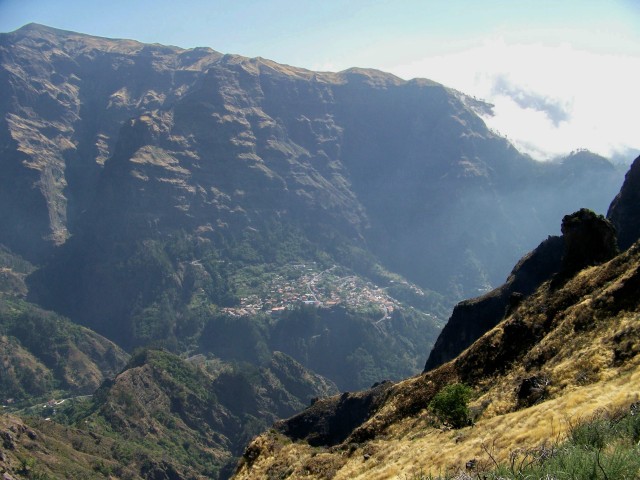

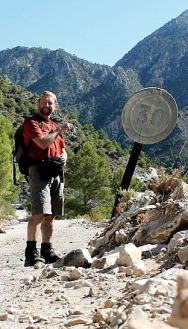



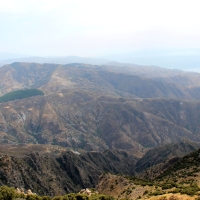



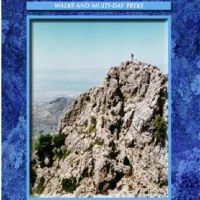

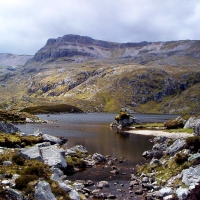
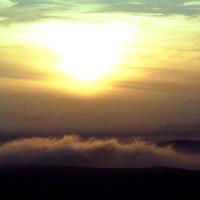



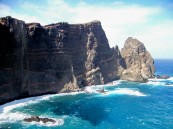

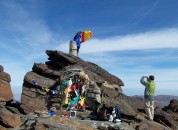




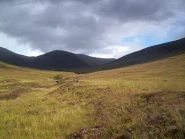




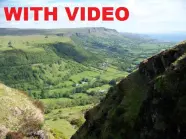
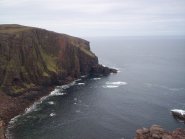
Aw! That was unfortunate indeed. Awkward moments with the workers too, I hate this kind of situation. But the worse is that you had to go back on your steps and see them again. I laughed when you said “this royal road, which has become a royal motorway thanks to the efforts of the workmen”, that but true. I think some parts of the world should remain accessible to people who really make the effort to reach them. It should be a privilege, not some kind of easy-access attraction for tourists. But then I dont know, in that case maybe they were building it to link villages or smthg? Anyway, great photos as always.
LikeLike
Thanks for that, Orel. I think it does a person good to have a painful day every once in a while. Just so long as they don’t happen too often.
LikeLike
God,I feel sorry for that poor wee boy humping slabs all day long.
Politicians/economists/bankers should be forced to watch folk like that toil for a day to put a human face to their actions.
On a lighter note,more good photos of what looks like a lovely island….
Alex.
LikeLike
I couldn???t agree more with you there, Alex. One half doesn???t know how the other half lives, but from where I???m standing most people live in the wrong half ??? which doesn???t seem to add up. And on a lighter note, get that plane booked!
LikeLike
Informative, entertaining, uplifting and depressing all at once. I don’t know how you manage to keep doing that, but it’s a lot better than watching the telly.
LikeLike
Thanks for that, Scott. I don???t know about better than watching the telly because I???ve just watched a programme about the development of high explosives on BBC4 and it was, er, explosive. Give those dogs a pat for me. Ta.
LikeLike
As ever a great read. Sounds like you had quite an adventure, it will certainly remain in your memory for a long time. As Alex and others have commented I feel sorry for the young lad toiling away on the mountainside. No doubt when his back or general health gives out they will simply replace him with someone else. I bet few of us pause to think about those who put their energy and in some cases lives into the construction of the pathways we use in the mountains. It brings to mind some exposed paths I have scared myself on such as the Camino Del Ray (Kings Way) at El Chorro in Andalicia, or many of the pathways in the Dolomites that were created during the wars.
LikeLike
It certainly makes you think. Even the stalkers paths that zigzag up into the corries and onto the ridges of the Highlands, and the original packhorse routes over places such as Styhead and Nan Bield, must have been constructed by similar groups of workers. As for the Camino del Ray ??? I was looking at some videos of it on YouTube only yesterday. Er . . . no thanks. I prefer solid ground under my feet!
LikeLike
Alen, great read as always. Fantastic scenery, never really considered the opportunities for walking on this island. I will tuck this away as a place to go when the weather is not so great here.
LikeLike
Cheers Mark. Apparently it’s a year-round destination, which I think means the sun shines all the time.
LikeLike
Hi Alen,
I can only echo the other readers comments, I am totally gutted for you- But it may not seem it as you wrote your post, but I bet right now, you can look down at your scared ankles & 70’s Y front T shirt & smile, no regrets…
Paul
LikeLike
Hi Paul. That cheered me up on a dull Sunday night. Cheers.
LikeLike